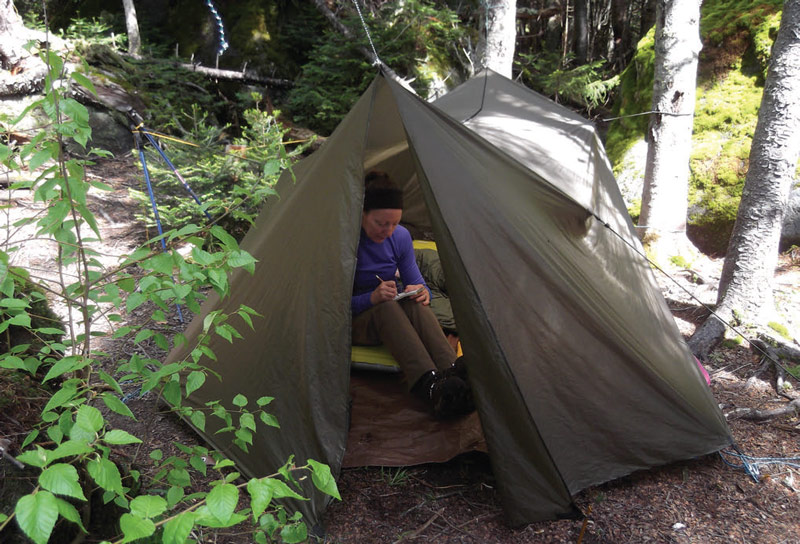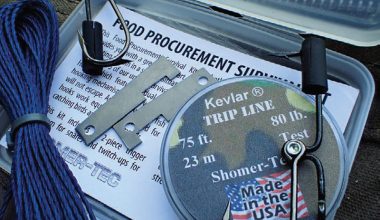When traveling on foot in the backcountry, it’s almost inevitable that the intelligent outdoorsman will seek out ways to lighten his gear load. Anyone who has dragged themselves up and down mountains will tell you how noticeable a few pounds of additional weight can be as the miles add up.
In rough terrain, any extra bit of carried weight can slow down (and wear down) the most fit among us, as well as increase the risk of injuries. Since the advent of modern high-tech fabrics, a new category of backpacking has emerged—ultralight.
Able to go farther and faster, this ultralight class generally refers to hiking with loads under ten pounds, not including consumables such as food and water, often referred to as the “base weight.” This specialty is not for everyone, but a lot can be learned from ultralight enthusiasts’ obsession with saving weight.
The shelter is considered one of the “big three” items with the greatest potential for saving weight, the pack and sleeping system being the other two. To meet the goals of an ultralight load, many enthusiasts set a goal that each of these items must weigh only one to two pounds.
Obviously this is not a one-size-fits-all situation, but gives an appreciation for the discipline of going ultralight. A benefit of studying and working with reduced poundages is that weight saved on one item can be added somewhere else. For example, I can bring a warmer sleeping bag without packing additional weight by trading weight somewhere else.

This review covers two ultralight shelters readily available to the public. First off, these shelters are floorless. Besides saving weight, this allows for a more versatile shelter that can be set up over rocks, stumps and generally rough terrain not suitable for conventional tents and portable shelters. A ground tarp is normally not a consideration for most ultralight trekkers because many use a waterproof cover for their sleeping bag system as well as a padded ground mat underneath, which keeps them from direct contact with the ground when sleeping and provides some insulation.
If the ground is extremely rocky or steep, a pocket-sized hammock can allow sheltering on terrain too severe for any other option. The hammock can be set up and the ultralight shelter configured over it for protection from the elements.
Why buy a pricey ultralight shelter and not just get a cheap tarp? A purpose-built shelter will set up more quickly in whatever configuration needed because the tie-off loops, grommets and guy-out tabs are built in. Many are engineered with tapers and bends along seams, making them very resistant to the noisy flapping in windy conditions for which tarps are notorious.
The purpose-built shelter will be lighter because stress areas are reinforced, allowing the lesser-stressed areas (the vast majority of the surfaces) to be made of lighter material. So overall they are lighter, quieter, and will set up faster.
One tradeoff to bear in mind is ruggedness. An ultralight shelter will typically not resist rough treatment as well as a heavier shelter built with thicker material. This is not normally a concern, as the primary purpose of a shelter is to protect the user from the elements. If you take reasonable care of your shelter, it will take care of you. If you need a shelter that is capable of surviving hard abuse, you should look at a thicker material and plan that into your gear load.

WARBONNET SUPERFLY SHELTER
I spent several nights above treeline in this shelter and was impressed with its overall design. By nestling it out of direct wind—as I would with any traditional shelter, in this case among boulders—it provided a roomy shelter for two and had no problem shedding snow and rain.
It is constructed of silicone-coated ripstop nylon, commonly referred to as Silnylon. The Superfly is designed to be stretched taut and is surprisingly strong, which makes sense as parachutes are traditionally made of ripstop nylon.

Although it measures 10’ x 11’, this shelter weighs in at a scant 1.18 pounds including its stuffsack. Many manufacturers of Silnylon tarps recommend that they be stuffed into a stuffsack as opposed to folded, and the Superfly is no exception. This reduces wear on the fabric and makes packing up camp faster. I have squashed my shelter down to the size of a soda can to see just how small it could compress if pack space became tight.
The Superfly was designed for hammock campers, but I found it to be perfectly suitable for floorless groundcamping, with door panels built into each end and plenty of room. The door panels have no zippers or fastening devices, but simply staggering the doors and pegging the ends into the ground worked fine to control the openings. Warbonnet makes a similar model specifically for ground sleeping and it has a few different features. I have not personally used that model.
Because it’s made of Silnylon coated with silicone, the Superfly is flammable, so keep the camp stove a healthy distance away.
Overall, the Superfly proved its worth and has become my primary go-to shelter for fast and light trekking.
SURVIVAL SOLUTIONS SWACK SHACK
This is a versatile shelter that makes a great bivvy cover as either a lean-to or tarp tent. Constructed of nylon ripstop fabric in Multicam® camouflage pattern, its 7.5’ x 9’ size is noticeabley larger than the standard USGI poncho dimensions (5.5’ x 6.6’).
It weighs 1.25 pounds and the back of the fabric is coated with urethane for waterproofing, but the center seam of the shelter is not sealed, so purchasers will have to do that themselves. If this is not done, heavy rain can push water through the thread stitching and infiltrate the dry side of the fabric. Seam sealing is fast and easy, so it was not a consideration when deciding to purchase the Swack Shack. Survival Solutions sells the waterproofing sealant for about $3.
There are three loops of nylon webbing along the spine and four grommets along each of the long sides. The stitching is solid and allows for a tight pitch. For a nice low shelter over a bivvy bag (or two), the Swack Shack is a fine improvement over the usual USGI poncho. It’s more durable, versatile and a larger, more useful size, yet still can fold down small enough to fit in a canteen pouch. I have pre-tied some paracord to the loops and bungees to the grommets, making this a fast and simple shelter to set up in a pinch.
Although it doesn’t offer the sheer volume of shelter space as the Superfly, the Swack Shack readily fills the niche of a simple tarp shelter that provides basic protection from the elements in a handy bundle.
For those hoping to use an ultralight shelter in a tactical environment, there is the blackout factor. Unlike many military tents and rainflys, ultralights rarely have a blackout coating on the fabric. This blackout coating minimizes light from escaping the tent, so those inside can use lights without being detected through the tent walls. The coating can be a separate fabric layer, so it increases the weight of the tent significantly.
Lacking this blackout coating, ultralight shelters usually light up like a paper lantern when those inside use white light after sunset. So if you’re going tactical, you’ll need to use a small light with a red filter and exercise serious light discipline to have any hope of staying concealed inside your ultralight shelter.
On the plus side, ultralights usually let in a lot of light through their thin walls in the daytime, so visibility inside is not an issue. Infrared fabric coatings are usually listed by the manufacturer if they are treated with such. As with any other piece of important gear, practicing with a new item in a non life-threatening environment is wise, and learning its limitations will help keep you safer in the long run.
Ultralight shelters are not for everyone, but for many they deserve consideration. Think lighter, faster, and safer.





